The Sistine Chapel is a chapel in the Apostolic Palace, the official residence of the pope. The chapel’s ceiling painting created by Michelangelo in the early sixteenth century is considered one of the greatest masterpieces of Western art.

The Chapel
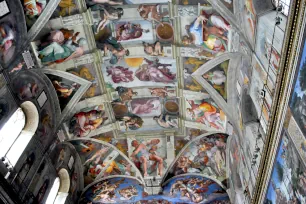
The Sistine Chapel was built in 1473-1481 by Giovannino de’ Dolci as a private chapel for pope Sixtus IV. It has a rectangular shape, 40.50 meters long, 13.20 meters wide and 20.70 meters high (133 x 43 x 68 ft.). A marble screen, created by a trio of artists, divides the room into two unequal parts. The floor is in opus sectile, in the style of the Cosmati, with beautiful geometric patterns.
The walls of the room are decorated with frescoes created in the fifteenth century by some of the best artists from Tuscany and Umbria. But as marvelous as they may be, they are overshadowed by the work of Michelangelo Buonarroti, who created the famous ceiling painting in 1508-1512 and, in 1534-1541, a wall painting of the Last Judgment.
The Ceiling Painting
Background

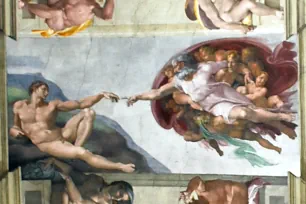
The ceiling of the Sistine Chapel originally resembled a blue starry sky. In 1508 pope Julius II asked Michelangelo to repaint the ceiling. Michelangelo only accepted reluctantly, since he considered himself a sculptor and architect rather than a painter. He even went as far as to sign the contract with ‘Michelangelo, sculptor’.
According to a rumor, his rival Bramante convinced the pope to assign the work to Michelangelo. Bramante hoped that Michelangelo’s reputation would suffer if he did a poor job; after all, he had basically no experience with such work. Julius II asked Bramante to create a scaffold for Michelangelo, who considered it unusable and instead created a scaffold himself. Soon after he started working on the ceiling frescoes, Michelangelo fired his assistants and continued painting the ceiling all by himself, all the time lying on his back.
Julius II wanted Michelangelo to decorate the ceiling with paintings of the twelve apostles. Michelangelo however decided to paint the ‘creation’ as written in the Old Testament. This made sense since the walls of the chapel were already decorated with other events from the bible.
The Frescoes
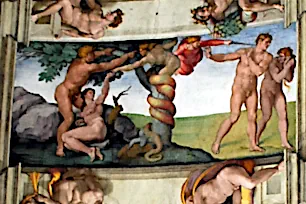
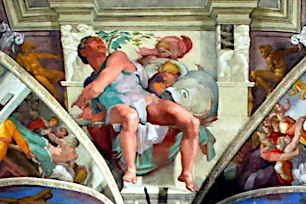
Michelangelo painted the ceiling with the then often used fresco technique, which meant that each day a layer of fresh plaster was laid and Michelangelo then had to paint that area before the plaster was dry.
The ceiling is divided into nine central sections that all depict scenes from the bible, starting with the ‘Creation of Light’ and ending with the ‘Drunkenness of Noah’ at the altar. Michelangelo actually started painting the other way around, and you can notice a difference in style as he perfected his style while painting. The most famous part of the fresco is the ‘Creation of Adam’, where Michelangelo depicts the almighty descending towards earth to give life to Adam.
Michelangelo painted classical architectural elements such as statues and pilasters to divide the different sections. Around the biblical scenes he painted prophets and Sibyls, prophetesses from the antiquity. The lunettes show portraits of Jesus’s ancestors, and the four triangular pendentives in the corners show scenes from the Old Testament.
The Wall Paintings
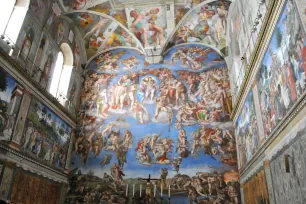
More than twenty years after completing his ceiling masterpiece, Michelangelo also painted the Last Judgment on the wall behind the altar. But while his former work received wide recognition, his painting of the Last Judgment drew criticism from puritans, who complained that there was too much nudity. Michelangelo responded by giving Minos, the donkey-eared judge of the dead, the face of his sharpest critic, Biagio da Cesena. After Michelangelo’s death, the painting was censored by the pope and all private parts were overpainted by Daniele da Volterra, who received the nickname ‘Braghettone’ (breeches maker).
The other walls are decorated with frescoes created between 1481 and 1483 by a group of renowned painters including Botticelli, Perugino, Ghirlandaio, Signorelli and Rosselli under the guidance of Pinturicchio. The paintings depict scenes in the lives of Jesus and Moses. They are considered masterpieces of the Italian Renaissance, but most visitors hardly even notice them, instead giving all their attention to Michelangelo’s works.
- Next: Vatican City
- More Sights & Attractions in Rome
- Related articles:

